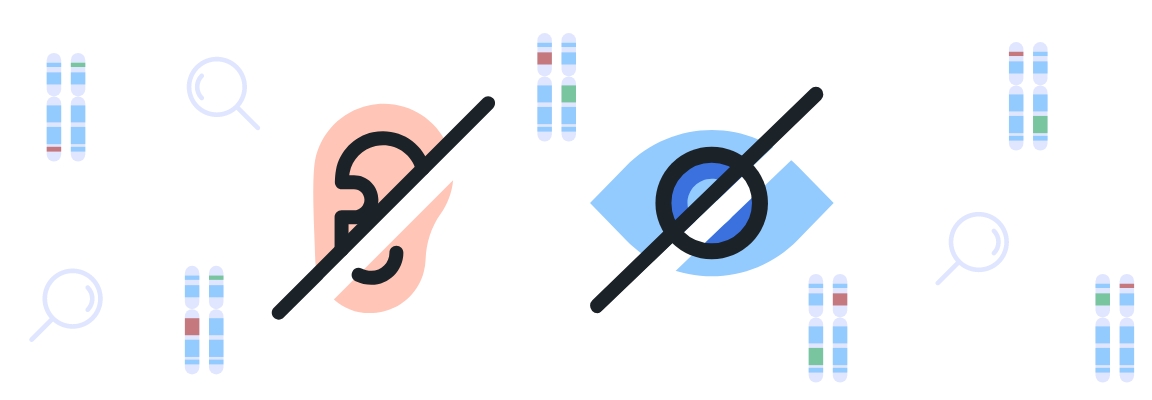The first thing we need to explain is that the name Usher syndrome comes from Charles Usher, a Scottish doctor who was the first person to discover the hereditary pattern of the pathology and its recessive inheritance.
This disease had already been described in 1858 by Albrecht Von Graefe, another ophthalmologist, this time German.
It has nothing to do with the books of Edgar Allan Poe, in case anyone was wondering.
Usher syndrome is an autosomal recessive disease that causes both hearing and vision loss, being the main congenital cause of deafblindness.
Its incidence varies by country, but it affects approximately 4 out of every 100,000 people. It accounts for half of all cases of congenital deafblindness worldwide.
It is responsible for 3-6% of cases of deafness in children, whether total or partial, and up to 10% of children born deaf.
The damage to the ear is due to the abnormal development of hair cells. These cells perceive vibrations and, in response, generate electrical impulses that they send to the brain, thus becoming the true receptors of sound.
They are essential for converting air vibrations into the sounds we hear, and unfortunately, in mammals, they cannot regenerate.
In the inner ear, we also have the vestibular system. This structure informs the brain of the position and speed of the head in space.
Additionally, Usher syndrome can cause the hair cells in the vestibular system to develop abnormally, leading to balance problems in some patients.
The damage to vision is due to retinitis pigmentosa. It is a progressive degeneration of the retina, resulting in the loss of the primary photosensitive cells, cones, and rods.
It typically begins with night blindness (difficulty seeing in low light) and loss of peripheral vision. Eventually, the patient is left with only central vision, known as tunnel or tubular vision.

One Gene, with Ten Possibilities, Affecting Three Senses
Although Usher syndrome is monogenic, this time we have several responsible genes.
So far, at least 10 genes are known to cause this pathology if they undergo mutations. Each of these genes, on its own, causes Usher syndrome, and we have 10 different ones.
Depending on the affected gene, the disease presents differences.
Usher syndrome is classified into three types, based on the degree of hearing and vision loss and the speed of progression:
- Usher syndrome type I. The person is born deaf and with balance problems due to damage in the vestibular system. Vision problems appear before puberty. Usher syndrome type I occurs due to mutations in 6 genes, with the MYO7A gene being the most common.
- Usher syndrome type II. The person partially loses hearing (hypoacusis) but does not become deaf. Vision problems do not appear until the twenties. There are no balance problems. It is believed to be more common than type I but is less diagnosed due to the more nonspecific and milder symptoms. In type II, there are 3 responsible genes, with the USH2A gene being prominent.
- Usher syndrome type III. The person progressively loses both vision and hearing. Balance problems may arise in later life. Interestingly, this is the least common type overall, except in the Finnish population, where it has the highest frequency. Type III is caused solely by the CLRN1 gene.
Diagnosing the Variety of Symptoms
A correct diagnosis of the disease starts with questions that help narrow down the possibilities.
Taking advantage of the fact that it is autosomal recessive, the family history can provide many clues about the syndrome.
This is combined with tests for hearing, balance, and vision—the three affected senses.
For the eyes, visual field tests and retina exams are performed. An effective method is the electroretinogram, a test that measures the electrical response of cells in the retina to light stimuli (the photosensitive cells are those affected in the disease).
For balance, another process with a peculiar name is performed: videonystagmography. This test is based on tracking eye movement and detects disorders in the vestibular system.
For hearing, audiology tests are conducted to detect frequencies in different sound ranges. If you are not a teenager (and even if you are), you have probably already undergone such tests.
When the suspicion is overwhelming and only minimal confirmation is needed, we finish with genetic testing. Knowing the 10 genes responsible for the syndrome, we check if they present pathogenic mutations.
The fact that the genes are normal is not an absolute guarantee that the patient does not have the syndrome. Until a few years ago, only 9 responsible genes were known. There may be an 11th gene out there, hidden, without anyone knowing.
Detection and Mitigation
The sooner the pathology is detected and diagnosed, the better the treatment outcomes will be. In children, they are more effective than in adults.
Unfortunately, these are treatments and not a cure. Usher syndrome is one of those conditions that, for now, last a lifetime.
The disease is present from birth and manifests early, depending on the type of syndrome. In children, education must be adapted to their symptoms, preparing them for sensory problems.
Cochlear implants are used to compensate for hearing loss, and it has been shown that vitamin A slows the progression of retinitis. Always with professional advice, turning your diet into just carrots is worse than not doing so.
Vision loss is more challenging to treat than hearing loss, and Usher syndrome always causes retinitis pigmentosa.
In the long term, there are several promising projects for treatment.
Since it is a monogenic disease, gene editing of the affected gene could reverse the syndrome. Other treatments in the pipeline include stem cell therapies, transplantation of modified cells, or gene modification exclusively in the retina.
As you can see (pun intended), the core of the problem, and of future treatments, lies in genetics. That’s why a DNA test like the one from tellmeGen can be an important first step.



